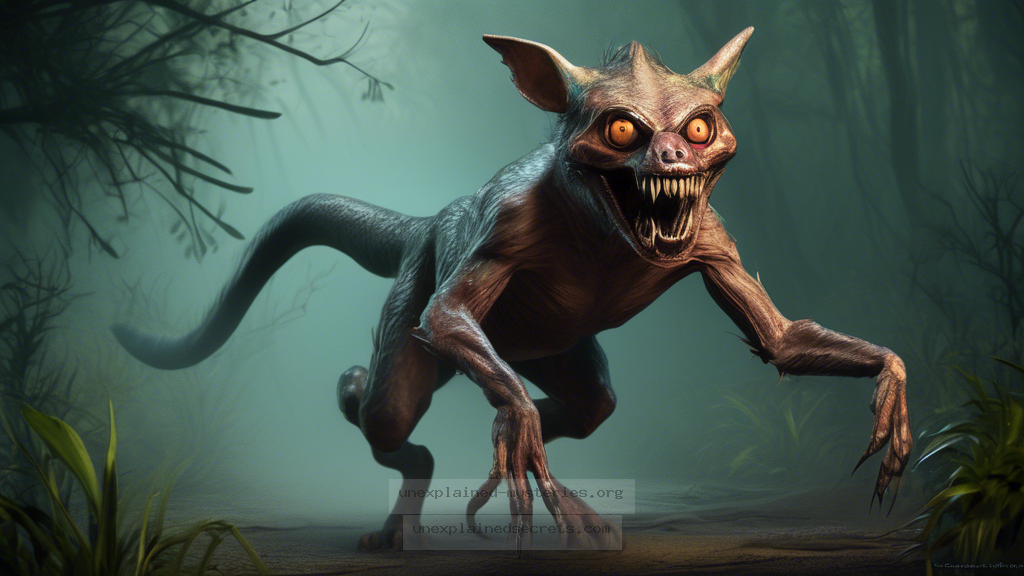Could the Chupacabra Be the Missing Link Between Known and Unknown Creatures?
Could the Chupacabra Be the Missing Link Between Known and Unknown Creatures?
The Chupacabra, a creature that has captured the imagination of cryptozoologists and the general public alike, is a prime example of a cryptid that blurs the lines between the known and the unknown. This elusive beast, often described as a vampire-like creature preying on livestock, raises compelling questions about what it truly is and how it fits within the broader context of cryptozoology. Understanding the Chupacabra not only expands our knowledge of potential undiscovered species but also highlights the cultural significance of cryptids in modern folklore. In this blog post, we will explore the origins, reported sightings, and implications of the Chupacabra phenomenon while addressing various theories related to its existence.
Historical Context: The Emergence of the Chupacabra Legend
The Chupacabra legend first surfaced in Puerto Rico in the 1990s, gaining notoriety after a series of mysterious livestock killings. Goats, sheep, and other livestock were found drained of blood, with puncture wounds on their necks, suggesting a predatory creature with a taste for blood. The term “Chupacabra” translates to “goat-sucker” in Spanish, encapsulating its gruesome feeding habits. Witness accounts varied, with some describing it as a reptilian creature with spikes along its back, while others depicted it as a dog-like being.
This phenomenon was not merely a local curiosity; it sparked media coverage that propelled the Chupacabra into the realm of urban legend. The combination of fear, fascination, and sensationalism contributed to its status as a cultural icon. Interestingly, the Chupacabra’s emergence coincided with a period of increased interest in cryptids and supernatural creatures, suggesting a societal yearning for mystery in an increasingly rational world.
Core Concepts: What Makes the Chupacabra Unique?
The Chupacabra stands out in the field of cryptozoology due to its distinctive characteristics and the nature of its reported encounters. Unlike many cryptids, which often have a single description or habitat, the Chupacabra has evolved in the public consciousness, showcasing various forms and behaviors. Some common descriptors include:
- Reptilian features with scaly skin and spikes
- Canine-like appearances resembling dogs or coyotes
- Heightened aggression and a penchant for blood-sucking
This variability in description invites speculation about its origins. Could the Chupacabra be a regional mutation of a known species, or perhaps a hybridization of various animals? The diversity of sightings suggests that the Chupacabra may embody more than one type of creature, existing at the intersection of myth and reality.
Scientific Investigations: Are There Any Concrete Findings?
Despite numerous sightings, concrete scientific evidence for the Chupacabra remains elusive. Researchers and cryptozoologists have attempted to analyze physical evidence, such as hair samples and carcasses, claiming to belong to the Chupacabra. In many cases, these samples have been identified as belonging to known animals—primarily canines suffering from mange, which can cause dramatic changes in appearance.
For example, in 2009, a specimen that was initially thought to be a Chupacabra was later revealed to be a coyote infected with sarcoptic mange. This finding underscores the importance of rigorous scientific methods in validating claims of cryptid sightings. However, the lack of definitive proof does not diminish the cultural impact of the Chupacabra; it remains a symbol of the unknown.
Alternative Perspectives: Folklore vs. Reality
The Chupacabra phenomenon raises questions about the line between folklore and reality. Some researchers argue that the creature is a modern myth, a reflection of societal fears and anxieties. As agricultural practices evolve and environmental factors change, fear of predation can manifest in the form of cryptids. In this view, the Chupacabra serves as a cautionary tale, emphasizing the need for vigilance in protecting livestock.
Conversely, proponents of cryptozoology argue that the persistence of Chupacabra sightings indicates a deeper truth. They assert that the existence of unidentified species is plausible, especially in remote areas where human populations are sparse. From this perspective, the Chupacabra embodies the potential for discovery, holding a mirror to our understanding of biodiversity and the natural world.
Common Misconceptions: Debunking the Myths
As with many cryptids, the Chupacabra is surrounded by misconceptions that blur the lines of its existence. Here are some common myths and the clarifications that accompany them:
Clarification: Various descriptions suggest the Chupacabra may represent multiple creatures or a cultural construct, rather than a single species.
Clarification: Similar blood-draining legends exist in various cultures around the world, suggesting that the Chupacabra taps into deeper, universal themes of fear and the unknown.
Best Practices for Investigation and Study
For those interested in investigating the Chupacabra and other cryptids, a systematic approach is essential. Here are some best practices for conducting research:
- Documentation: Record sightings with as much detail as possible, including location, date, and witness accounts.
- Collaboration: Work with local experts, wildlife biologists, and other researchers to analyze findings and share insights.
- Scientific Rigor: Ensure that any physical evidence is analyzed using proper scientific methods to confirm or debunk claims.
- Respect Local Culture: Understand the folklore surrounding the Chupacabra to contextualize sightings within cultural narratives.
Future Developments: What Lies Ahead for Cryptozoology?
The future of cryptozoology, including the study of the Chupacabra, is poised for evolution as technology advances. Innovations in genetic analysis, environmental DNA (eDNA) sampling, and wildlife tracking are likely to enhance our ability to explore the unknown. As scientists increasingly embrace interdisciplinary approaches, the lines between folklore, ecology, and biology may blur, leading to groundbreaking discoveries.
Moreover, the global interest in conservation and biodiversity may provide renewed focus on mythical creatures like the Chupacabra, as researchers seek to understand the ecosystems in which these creatures supposedly reside. Ongoing public interest in cryptids also helps fund and promote investigations, ensuring that the mystery of the Chupacabra persists.
Conclusion: The Enduring Allure of the Chupacabra
The Chupacabra serves as a fascinating case study in cryptozoology, challenging our perceptions of reality and the boundaries of science. While definitive evidence remains elusive, the creature’s place within cultural folklore, the ongoing investigations, and the societal implications of its legend highlight the powerful intersection of myth and reality.
As we continue to explore the unknown, the Chupacabra reminds us of the mysteries that still linger in the shadows of our world. Whether a product of folklore or a potential undiscovered species, its story invites us to question what lies beyond our current understanding and inspires curiosity in the pursuit of knowledge.
Other Articles
Recent Posts
- What Happened to Flight MH370? The Conspiracy Theories That Still Haunt Us
- What Secrets Lurk Within the Walls of the Infamous Trans-Allegheny Lunatic Asylum?
- What Evidence Supports the Existence of Bigfoot in the Pacific Northwest?
- What Happened to the Indus Valley Civilization? Unraveling the Mysteries of Ancient Urban Life
- Can Telepathy Be Scientifically Proven Through Laboratory Evidence?







